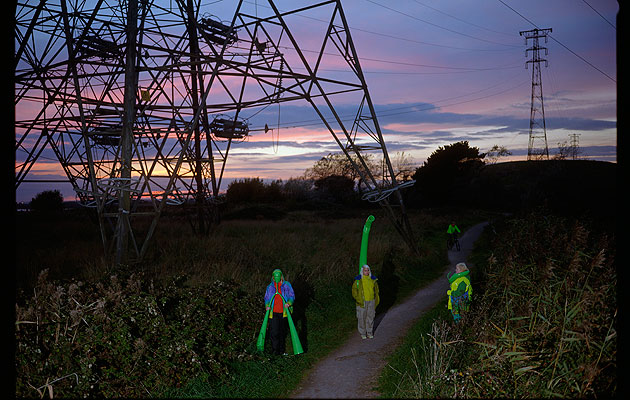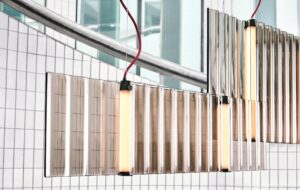|
|
||
|
Do you know about gizzards,” asks Anthony Dunne excitedly. Luckily the question is rhetorical and the answer comes with the next breath. “The gizzard is an organ in a bird that can literally grind metal down to nothing. They will often eat a pin or a paper clip by accident and this organ just grinds it.” This is just one of many nuggets that Dunne and his partner Fiona Raby, of design duo Dunne & Raby (Icon 022), have come across in the research for the studio’s latest project, Foragers. Foragers looks at how humans could extract nutritional value from non-human foods by using a combination of synthetic biology and new digestive devices inspired by other mammals, birds, fish and insects. “We are outgrowing our species,” says Dunne. “In 2050 the world’s population will be 9 billion. If we want to keep on overpopulating, not change our attitudes and consume like crazy, maybe genetic engineering is the only way forward?” It is a provocative argument, and Foragers can, like many of Dunne & Raby’s other projects, be described as an exercise in critical thinking rather than a piece of design. The project first came about when South African organisation Design Indaba asked Dunne & Raby to look at the future of farming. It resulted in a two-minute animation, but Dunne & Raby continued developing the project and now the original theory of genetically engineered digestive tracts is expanded with a series of four objects that illustrate this novel approach to foodstuffs and storing energy. Foraging has romantic connotations of searching for food in the wild, but Dunne & Raby’s foragers are genetically reconfigured human beings that go at nature with full force, trying to process trees, cellulose and plant matter as nutrition. Rather than a line of products for sale, the project imagines people coming up with DIY self-modifications. “We were interested in this idea that rather than changing the environment we should begin to change ourselves,” says Raby. “On one level that’s literal – changing our digestive system – but also changing our values and attitudes, our relationship with limited resources.”
We meet in Dunne & Raby’s East End studio, but none of the designs are there as they are currently being prototyped. In fact, there is nothing at all of Dunne & Raby’s design work on view, a reflection of the practice’s broader attitude. “We’re not interested in making products or things; we’re interested in new ways of thinking,” says Dunne. “The projects for us are experiments and ways to test an idea or approach.” The practice is more about unlocking the potential of design by coupling it with other disciplines and Dunne & Raby is going to great lengths to prove that its thinking could work – in theory at least. “We often consult scientists or manuals or books just to check that what we’re doing has a plausibility about it,” says Dunne. “We’re not worried about things fully working today, but equally we don’t want them to be complete fantasies.” The four Foragers objects are rather fantastical though. The grass processor is the most disturbing – it’s a facemask connected to long arm extensions that reach the ground where it is supposed to suck up nutrition from grass and weeds. The tree processor is easier on the eye – one giant proboscis reaching skywards for easy access to the tree canopies. The algae digester is a round flotation device that sits on the water while processing nutritional water plants. The augmented digestive system, which is a round neckpiece, represents the most extreme scenario, where your internal digestive system is genetically changed in order to cope with the novel food. “The idea is that there are different varieties of implements, depending on how extreme you feel,” says Raby about the range of objects. “Those that are squeamish would have their digestive system around their necks; ladies might even have trolleys to keep their new stomachs separate from them. Real fanatics would adapt their own bodies; their own biology.” Raby clicks open the research folder on her computer and a gallery of images of wood chippers and forestry machines pops up. The birds’ gizzards that Dunne talked about earlier are illustrated with sink grinders. The four objects hint at bodily extensions; appendages hang from the arms or protrude from the back. But Dunne and Raby have picked a fluorescent green for the prototypes. “We didn’t want them to look like fleshy extensions to the body, but a new type of biological machinery,” says Raby. This winter Dunne & Raby is presenting the finished result of this research in an exhibition at the Design Biennale in Saint Étienne (17 November – 5 December) called Between Reality and the Impossible – an appropriate title for the duo’s work. Here, the Foragers project is represented through the physical objects, photographs by Jason Evans that place the works in futuristic scenarios and in a series of short stories by the writer Alex Burrett. “Rather than sealing everything up tightly, we’re doing the opposite,” says Dunne. “Then hopefully when others see the pieces other kinds of associations and stories will evolve.” Ultimately Foragers is a think piece, a way of provoking some sort of reaction in viewers. It occupies what Dunne and Raby call a “what if” space. “This is somewhere between commentary, which we’re not interested in, and problem solving, which we think is impossible,” says Dunne. “As designers we lean towards the optimism of thinking that there has got to be a way of sorting this out, but we love the kind of aesthetic, poetry and irony that comes with comment.” |
Image Jason Evans
Words Johanna Agerman Ross |
|
|
||
|
|
||



















